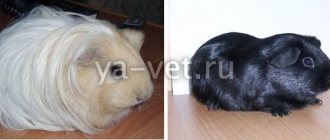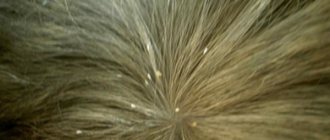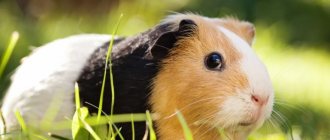The guinea pig is characterized by periodic scratching - this is how it takes care of itself. But when she is bothered by ectoparasites, she itches often and for a long time, bites her fur, trying to gnaw them out. Flea bites in guinea pigs can cause wounds, abrasions, suppuration, and allergies (due to antigen proteins contained in the saliva of insects).
Ectoparasites carry infectious diseases, eggs and larvae of helminths. In order not to endanger the health of the pig, its owner must know how to identify and remove them in a timely manner.
If your pig begins to chew out its fur before sores appear on its skin, then the animal may have fleas.
Carrying out diagnostics
You can identify fleas yourself. They can be seen with the naked eye on the rodent's face and stomach. If you comb the fur with a single-row, fine-toothed comb, it will leave behind insect excrement in the form of small brown clumps, as well as dead or living insects. Parasites are easier to detect on animals with light fur.
If the diagnosis is carried out by a veterinarian, he takes a scraping from the rodent's skin for examination.
A pig can have several diseases at the same time, for example:
- allergic dermatosis;
- ectoparasites;
- streptococcal infection;
- neurodermatitis;
- mycoses.
Any of these factors, as well as metabolic disorders and poor nutrition, cause itching, sore skin and hair loss.
To determine the presence of the disease, a scraping is taken from the animal's skin.
Treatment methods
Fleas in a guinea pig, like other pests, must be destroyed as soon as possible, before they cause serious harm to the rodent.
The very first step is to clean and disinfect the cage. The litter must be completely replaced. Plates, toys, shelter - everything must be thoroughly washed and treated.
Flea sprays
To get rid of fleas and lice, sprays are used:
The procedure must be repeated after 8 days. Instructions and dosage are indicated on the drug packages. The affected pet must be treated so that the product does not get on the mucous membranes, including the mouth.
What symptoms indicate the presence of fleas
Signs that an animal is being bitten by fleas are as follows:
- redness and peeling of the skin, bite marks (usually on the stomach) in the form of red dots;
- the pig behaves restlessly, shakes its head, itches, eats poorly, becomes less active;
- In places where insects accumulate, hair loss may occur.
Insects pierce the skin and drink blood. The bites are painful, and there are no anesthetics in the saliva. In the affected areas, the skin becomes inflamed, itches, and hurts when scratched.
Flea bites cause red spots on your pig's skin.
lice eaters
This is another type of parasite that differs in that it can feed not only on particles of the animal’s skin, but also on its blood. Due to the small size of the parasites, it is quite difficult to detect them with the naked eye; you will have to use scraping. The first signs include hair loss of the animal, as well as itching. An animal's reduced appetite threatens death from exhaustion. The danger is that lice can get on the animal even with careful care, for example, through the owner’s clothes or toys from the store.
Comprehensive treatment measures include treating all animals that have previously been in contact with or are close to an infected individual, even if they do not show signs of infection.
Akaromectin, Bolfo and Bars spray can be used as medical assistants in the fight against lice eaters. Due to the fact that bathing is considered extremely stressful for pigs, it is best to opt for a spray, as it will cause them less discomfort. The animal does not resist the procedure and, if necessary, it must be repeated the prescribed number of times. This is usually done by a veterinarian. Lice remedies are also available in human pharmacies, but you need to choose those options that contain the substance permethrin. The largest number of breeders recommend choosing Advocate spray. Due to the content of fewer toxic substances, it is safer for the animal.
Lice eaters are localized in the croup and perineum; they parasitize at the roots of the hair, wrapping their limbs around the hair, and feed on blood, epidermal scales and secretions of the sebaceous glands. As a result, the affected hair falls out. Lice eaters are most active in winter, when the guinea pig's fur becomes thicker and longer, which is a favorable factor for the proliferation of parasites.
Lice feed on blood and are able to actively move around the animal’s body, causing itching. Parasites can be seen with the naked eye when parting the fur, mainly in the head area and around the ears.
Guinea pigs become infected with lice and lice through contact with sick relatives, through bedding and food.
Lice and lice cause itchy skin and severe anxiety in a sick animal, up to the appearance of seizures and convulsions. Fleas with intense infestation can cause inflammation of the skin - flea dermatitis. It is characterized by redness of the skin, baldness, and eczema.
What other parasites can pigs get?
Several types of parasites can appear on pigs:
- Ticks. Sources of infection are other animals, human skin and clothing, and poorly washed food. First, mites infest the skin of the head, back and sides, then the entire body. Depending on the species, they settle on the surface of the skin or in the depths, eating away passages in the tissues. Causes severe itching. The animal injures itself with constant scratching, experiences stress, and reaches exhaustion. A pregnant female may have a miscarriage.
- Lice. Insects are yellowish in color, smaller than fleas. Infection occurs through contact with other animals or through bedding. Lice bite into the skin and feed on substances that are released. This causes itching, redness, crusts and papules. With severe infestation, the fur around the ears and lower abdomen becomes dull. Parasites lay white eggs called nits on hairs. Lice living on guinea pigs are species specific. They cannot be transmitted to humans.
- Vlaseaters. These are yellowish-gray worms up to 1 mm long. They hold tightly to the animal’s body with the help of 3 pairs of legs and multiply quickly: 1 female lays about 70 eggs (nits) at a time. They feed on epidermal particles and fur, contaminating the skin and chewing hairs. Causes skin irritation, dermatitis and baldness. Sources of infection are sick pigs, sawdust, and unsealed food. Lice eaters are not dangerous to people.
Ticks can be detected by laboratory testing of skin scrapings or on litter. They look like small dots (hungry insects are gray, and those that have drunk blood are red-brown).
Lice and lice can bring a lot of unpleasant moments to your pets.
Routes of infection
Fleas are known to be jumping creatures that move from one animal to another. Most often, infection with ectoparasites occurs from other pets with whom the guinea pig comes into contact. A rodent has every chance of encountering arthropods on the street, especially while walking on the grass.
In most cases, cat fleas are found on domestic rodents. This type of ectoparasite is adapted to exist both in private households and in apartments. Despite the name of the insect, the cat flea lives not only on cats, but also in the fur of dogs, domestic hedgehogs, rats and other rodents.
Methods for removing parasites
For treatment use:
- Shampoo. When bathing, apply to wet fur and rub over the entire body so that it does not get into the eyes and ears. The product must be rinsed off well. When it enters the body, the digestion of animals is disrupted. You need to wash the cage and the area near it with the same shampoo, and change the bedding. The procedure is repeated after 10 days to destroy the larvae. When choosing this method of treatment, one must take into account that pigs are afraid of water and experience stress when bathing.
- Spray. The jet is directed onto the skin against hair growth. Most drugs have an unpleasant odor, so it is better to carry out treatment on the balcony or on the street. The pig should be held in your hands until the spray dries to prevent it from licking the medicine.
- Drops. The dose is drawn into a syringe, the needle is removed, the fur is pulled apart and dripped onto the skin, but not onto the wounds. You need to hold the animal in your hands for about 10-15 minutes until the product is completely absorbed.
- Injections. Subcutaneously into the withers.
Basic rules of treatment:
- at the same time it is necessary to process the hair of all domestic animals;
- every 3 days, disinfect cages and bedding (they must always be dry);
- You cannot use several different drugs at the same time;
- the preparations Neostamazan, Ethnomazan, Stomazan, Butox are not used for pigs (they can only treat surfaces - cages, bedding and other equipment).
The cage must be cleaned every three days.
Used against fleas:
- drops – Advocate, Blokhnet, Stronghold, which can be combined with anti-inflammatory and antimicrobial drugs;
- shampoo “Nizoral” and others containing pyrethritol;
- sprays – 8 in 1, Frontline, Bolfo.
Do not exceed the dose - this can lead to poisoning of the pig. It is better to buy special preparations for rodents. When using medications intended for kittens, take 0.1 ml of Advocate or 6 ml of Stronghold per 1 kg of pig's weight.
Use flea drops in conjunction with antimicrobial drugs.
The above sprays and drops are used against ticks in the same way, as well as injection preparations:
- Ivermectin. Per kg of weight, 0.02 ml of the drug is combined with 0.2 ml of saline solution. The product is considered difficult to use, since it is difficult to calculate the dose and measure it, and exceeding it is dangerous for the pig’s brain.
- Otodectin (variation with 0.1% ivermectin) at the rate of 0.2 ml/kg.
Injections are given once every 10 days, 2-4 injections in total (depending on the degree of damage). Ivermectin is applied to inflamed areas of the skin 2-3 times a day. The cage needs to be washed with a solution containing chlorine and the bedding changed.
The results of scraping tests are positive in only 45-50% of diseases, so the same treatment can be prescribed in case of suspected mite infection with negative results of scrapings. The effect is observed within 3-4 weeks.
Often a tick infection is complicated by the appearance of a fungus. It primarily affects the scalp, neck and extremities. It is treated with Chlorhexidine, Lamizine, etc.
We make injections into the animal's withers.
Help against lice and lice:
- sprays Bars, Celandine, Bolfo, Dana, Akaramectin;
- Ivermectin injections (if there are a lot of parasites);
- Advantix drops, Frontline, Advocate.
If nits are present, the treatment is repeated after 2 weeks. Insecticides kill only adult insects.
The least toxic are pyrethrin-based preparations, such as 8 in 1 sprays and Beaphar. They can be used to treat pregnant and lactating females and cubs weighing up to 500 g.
Sprays against lice and fleas destroy only adult individuals, but not nits.
[vote2x id=”2300" align=”center”]
Prevention
If in addition to the guinea pig, there are other pets in the house - cats or dogs, they must be regularly treated with insecticides so that they do not catch the infection and “reward” the little pet with it. This rule especially applies to those pets who are allowed to go outside for a walk.
The usual requirements for the conditions of keeping a pig play the role of preventive measures. These include:
- cleaning the animal's house;
- changing filler and bedding;
- treating the pet's cage and items with disinfectants.
All this should be done regularly and on an ongoing basis, and not just during or after an illness. Before going on walks, your pig needs to be protected against parasites.
It is very important to seek medical help at the first symptoms of infection. The consequences of an advanced disease are irreversible for the animal’s body, which leads to its death. The sooner treatment is started, the greater the chances of ridding your pet of the disease and returning him to his normal life and normal well-being. It is not worth treating the animal on your own - only a veterinarian can prescribe the correct treatment. Self-selected therapy can cost the animal its life. Control by a veterinarian and a responsible approach to healing your pet are the key conditions that will soon allow you to see your pet healthy and active.
Preventive actions
To prevent infection with ectoparasites, pigs need proper care and maintenance, the nature and characteristics of which are as follows:
- periodic examination of all pets;
- treating all items they use with insecticides;
- disinfection of feed purchased in bulk (it is kept in the freezer for 1 day);
- maintaining personal hygiene before interacting with a rodent.
Pets that are taken for walks should wear tick collars in the spring and summer. During this period, parasites are especially active. Some of them are carriers of the meningoencephalitis virus, which is dangerous for animals and people.
The weakened immunity of the pig can become the basis for the appearance of subcutaneous mites and fungal diseases. An unhealthy animal with poor appetite becomes depleted quickly when attacked by parasites.
To improve health, vitamin complexes (C, B1, B2, A, E, folic acid), drugs with anti-inflammatory, antitoxic and immunostimulating effects are prescribed - Sporovit, Katozal, Gamavit, etc.
If your pig develops itching and anxiety, it is best to contact a veterinarian or rodentologist (a specialist in small exotic mammals) and undergo treatment under medical supervision.
Ticks
Perhaps it’s not fleas that have clung to your pet, but scabies or fur mites. Do pigs have ticks? Such cases are observed. Don't worry, with proper treatment, the parasite is easy to get rid of. To avoid confusing your guinea pig's fleas with a tick, examine your pet. If it is a scabies mite, you will notice the following symptoms:
- skin itching;
- rough areas on the skin;
- areas with lost hair.
However, the tick itself cannot be detected: its size is too small.
The fur mite has similar symptoms: the pig itches, its fur becomes coarser, becomes sparse, and dandruff appears.
The veterinarian will definitely examine the hairs and skin particles under a microscope. Treatment in both cases is identical: most likely, it will be drugs based on ivermectin. They are prescribed courses. The animal's fur is processed several times.
Do you have other pigs who have had direct contact with the sick pet? If yes, then treatment should be carried out for everyone. At least carry out a one-time treatment of animals as a preventive measure. In addition, the cell should be treated with sulfuric lime. Make sure your pigs don't swallow any medications! This is dangerous to your health.
What is it and what does it look like?
Ringworm is a dermatological viral disease caused by the active growth of fungal cells. A disease occurs on the skin. The first symptom is:
- hair loss;
- peeling;
- redness;
- itching
If you do not help your guinea pig in time, the lichen will quickly spread throughout the rodent's entire body. In addition, other animals living in the same cage with the patient, as well as the animal’s owners, are at risk of infection.
A loving owner always worries when a pet is unwell. When faced with a similar problem for the first time, the question will invariably arise of how to deal with the virus.
Guinea pigs are susceptible to two types of lichen:
- Trichophytosis;
- Microsporia.
Spores of both fungi can be stored for quite a long time on the skin of animals, in the soil, on objects before becoming active.
It is not at all necessary that the carrier animal will suffer from any type of lichen. Most often, the disease progresses on the body of animals that are kept in unsanitary conditions or have weak immunity.
Worms
Due to the fact that the main property of this group of parasites is to absorb nutrients from the animal’s blood, this can lead to exhaustion. Typically, guinea pigs are inhabited by tape and round parasites. Worm larvae of this type are dangerous not only for the animal, but also for the owner. With severe infection, you can see not only worm larvae in the stool, but also quite adult individuals with the naked eye. The animal is characterized by lethargic behavior, drowsiness and decreased appetite. If the infection is very strong, parasites crawling out of the anus can also be seen with the naked eye.
If the infection is not severe, you can give the animal a suspension of prazicide for kittens. The amount is calculated at the rate of 1 gram per 1 kg of animal weight. Dirofen paste has a good reputation among veterinarians. When treating an animal with medications, you need to treat the cage and accessories with a chlorine-containing solution.
How can a guinea pig get lice?
In most cases, infection occurs during direct contact of an animal with a sick relative. In addition, the animal can “pick up” lice when using contaminated litter or dishes. For this reason, you should only use clean bedding and never use used care products. The highest risk of infection is in young or old pigs, as well as in initially weakened, emaciated animals.
There are, however, more exotic cases of infection. So, if the owner has been in contact with a sick pig, he may well bring parasites to his home on his hands and clothes. This happens especially often when children act as breeders: they constantly play with each other’s pets, and therefore one lousy pig is enough to infect dozens of other animals, which may well live on opposite ends of the city.
Diseases dangerous to humans
- Strongyloidiasis,
- Giardiasis,
- Encephalitis.
Giardiasis
Symptoms of infection:
- Nausea,
- Stomach ache,
- Bloating, gas formation, constipation and diarrhea, replacing each other,
- Skin rashes
- Fatigue, increased drowsiness, loss of appetite, poor sleep and frequent dizziness.
Tick-borne encephalitis
If a guinea pig walks outdoors in the summer, it needs to wear a special anti-mite collar. Otherwise, there is a high risk that the animal will bring back a tick infected with encephalitis from a walk. This disease is dangerous not only for pigs, but also for humans.
An ignorant person, looking at an actively itching pig, is sure that this is how guinea pigs manifest themselves. But this is far from true: the most common cause of itching is one of the types - fur or scabies.
Scabies
This species is more dangerous for a “sea” pet. When it appears, the following symptoms are possible:
- the appearance of papules;
- skin redness;
- the appearance of areas with rough skin;
- hair loss.
Only a veterinarian can accurately determine the culprit. He will do this after examining a scraping taken from the animal’s skin.











